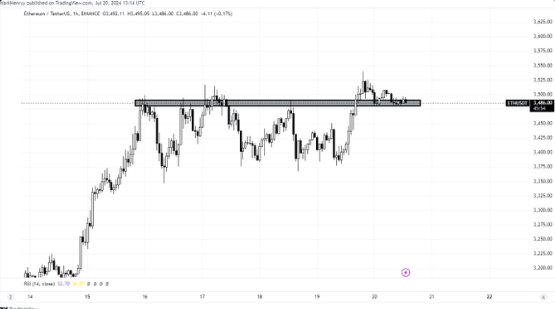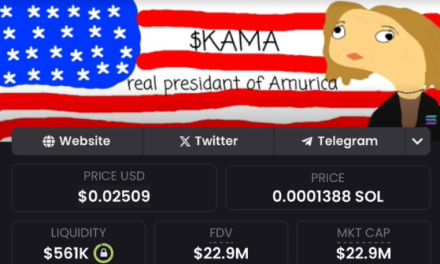After years of regulatory hurdles and numerous amended filings, spot Ether exchange-traded funds (ETFs) are finally debuting in the market. For the first time, shares of publicly-traded Ethereum (ETH) ETFs will be listed alongside major stocks like Apple Inc. (AAPL) and the SPDR S&P 500 ETF Trust (SPY) on some of the most popular brokerage platforms in the United States.
🔥Cuban’s Bitcoin Bet, Venezuela’s Crypto Surge!🔥
Tomorrow’s daily combo inside! 👀
Bitcoin as a global reserve? Wall Street’s crypto shift. SEC approves Ethereum ETFs + more!
PLAY GEMZ: https://t.co/ZOrcz6HUJR pic.twitter.com/ldgQ9Wh5YK
— gemz (@gemzfun) July 20, 2024
This development is a significant milestone for cryptocurrency markets and presents a new investment opportunity for millions of US institutional and retail investors. Here’s what you need to know to take advantage of this new financial instrument.
When will spot Ether ETFs be available?
The Chicago Board Options Exchange (CBOE) has confirmed July 23 as the launch date for five ETFs on its platform: 21Shares Core Ethereum ETF, Fidelity Ethereum Fund, Invesco Galaxy Ethereum ETF, VanEck Ethereum ETF, and Franklin Ethereum ETF.
Additionally, four other spot ETH ETFs are expected to trade on either Nasdaq or New York Stock Exchange (NYSE) Arca, although official announcements from these exchanges are still pending. However, these listings are also anticipated to occur on July 23.
Where can I buy Ethereum ETF shares?
These ETFs will be accessible through virtually any major brokerage platform. Every spot ETH ETF set to list in late July has received regulatory approval to trade on at least one major U.S. exchange, such as Nasdaq, NYSE Arca, or CBOE BZX.
Retail investors do not trade directly on these exchanges; instead, they use brokerage platforms like Fidelity, E*TRADE, Robinhood, Charles Schwab, and TD Ameritrade as intermediaries. Once ETH ETF shares are listed on public exchanges, all major brokerages are expected to facilitate trades.
What are my options and how do I choose the best one?
Nine spot Ether ETFs will begin trading, and they are similar in their underlying mechanics. Each ETF is managed by a reputable fund manager, holds spot ETH with a qualified custodian, and uses a group of professional market-makers to create and redeem shares. They all offer standard investor protections, including insurance against brokerage failures and cybersecurity risks.
ETHEREUM ETFs LAUNCH July 23rd! pic.twitter.com/OFCzs68tRo
— The Crypto Report (@_CryptoReport) July 20, 2024
For most investors, the deciding factor will be the fees. Management fees for eight of the nine ETFs range from 0.15% to 0.25%. Grayscale Ethereum Trust (ETHE), which began trading under a different fund structure in 2017, still charges higher management fees of 2.5%.
Many Ethereum ETFs are temporarily waiving or discounting fees to attract investors. Grayscale Ethereum Trust and Invesco Galaxy Ethereum ETF (QETH) are exceptions. The Grayscale Ethereum Mini Trust (ETH), a newer fund specifically created to list as an ETF, has a management fee of 0.15%, waived for the first six months or until the fund reaches $2 billion in assets under management (AUM).
Another attractive option is Franklin Templeton’s Franklin Ethereum ETF (EZET). Its management fee is 0.19%, fully waived until January 2025 or until the fund exceeds $10 billion in AUM.
Will spot Ether ETFs offer staking?
Currently, the answer is “No,” but there is potential for future changes. Staking involves depositing ETH to a validator node on Ethereum’s Beacon Chain, earning network fees and rewards but also risking “slashing” if the validator fails.
Staking enhances returns, with annual rewards around 3.7% as of mid-July. Earlier this year, issuers like Fidelity, BlackRock, and Franklin Templeton sought regulatory approval to add staking to spot ETH ETFs, but the SEC denied these requests due to liquidity concerns. Staked ETH typically takes days to withdraw, posing a problem for issuers who must promptly redeem ETF shares for underlying assets.
$ETH ETF in a few days. I think Ethereum ETFs have a better chance of lifting all tides than Bitcoin ETFs.
This gonna pull a candle soon.
ETH Broke out of its range on 1H TF. Resting previous resistance as support. $BTC looking even better.
Funding neutral/negative across… pic.twitter.com/9MU3MA51AF
— Henry (@LordOfAlts) July 20, 2024
Issuers are exploring ways to add staking to current spot ETH ETFs, potentially by maintaining a liquid Ether buffer, but a practical solution is months away at best. For now, staking remains unavailable for Ether ETFs.
Major Points:
- Spot Ether exchange-traded funds (ETFs) will launch on July 23, marking a significant milestone for cryptocurrency markets.
- Five ETFs will trade on the Chicago Board Options Exchange (CBOE), with additional listings expected on Nasdaq and NYSE Arca.
- Major brokerage platforms like Fidelity, E*TRADE, Robinhood, Charles Schwab, and TD Ameritrade will facilitate trading of these ETFs.
- Nine spot Ether ETFs will be available, with management fees ranging from 0.15% to 2.5%, and some ETFs offering temporary fee waivers.
- Currently, staking is not available for Ether ETFs due to liquidity concerns, although future solutions are being explored.
Conner T – Reprinted with permission of Whatfinger News







